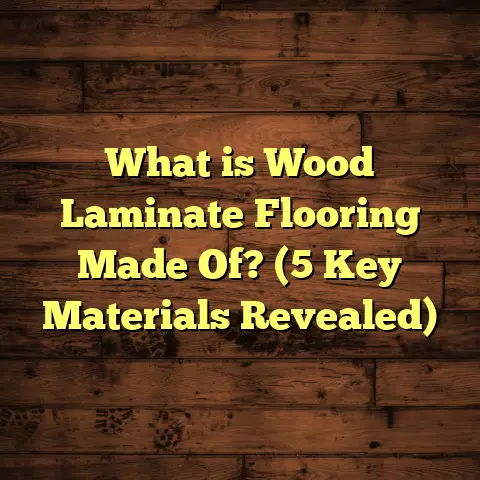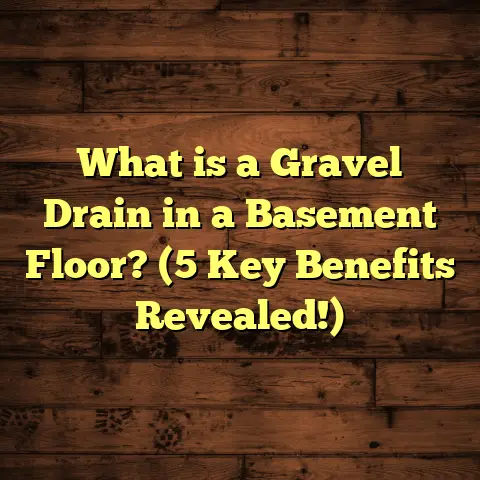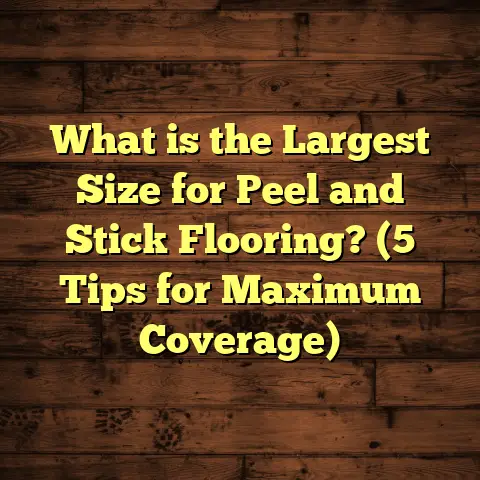What is Peel and Stick Vinyl Flooring? (5 Benefits for DIYers)
I want to start by sharing a mistake I see a lot of people make when they decide to redo their floors: they jump straight into buying expensive materials or hiring pros without knowing if the flooring suits their needs or skills. I’ve been there myself, eager to get a fresh look without thinking about how tough the installation might be or what maintenance would involve. That’s why I want to talk about peel and stick vinyl flooring today—a solution that saved me time, money, and a lot of headaches.
What Is Peel and Stick Vinyl Flooring?
Peel and stick vinyl flooring is exactly what it sounds like: vinyl tiles or planks with an adhesive backing that you simply peel off and stick onto your floor. It’s a floating floor system—meaning you don’t have to glue it down or nail it in place. This kind of flooring is designed for easy installation, making it perfect for people who want to handle their own projects without calling in a pro.
Unlike traditional vinyl sheets that require messy glue and careful cutting, peel and stick tiles come in manageable sizes, usually 12×12 inches or similar, and sometimes planks that mimic hardwood strips. You just prep your surface, peel off the paper backing, and press the tile firmly in place. No special tools, no drying time, just a little patience and precision.
Peel and stick vinyl has been around for decades but has improved significantly over the years with better adhesives and more realistic designs. The vinyl itself is usually made from PVC (polyvinyl chloride), which is durable and water-resistant.
What Makes Peel and Stick Different From Other Vinyl Flooring?
Traditional vinyl flooring comes in two main types: sheet vinyl and luxury vinyl planks (LVP) or tiles (LVT). Both usually require glue or click-lock systems for installation. Peel and stick vinyl cuts out the middleman by having adhesive pre-applied, simplifying both the purchase and installation process.
Compared to laminate or hardwood floors, peel and stick vinyl doesn’t require underlayment or acclimation time; it can be installed directly over existing floors as long as they are smooth and clean.
Why I Recommend Peel and Stick Vinyl Flooring for DIYers
I’ve installed all sorts of flooring in my time—from hardwood to laminate—but peel and stick vinyl has some benefits that make it stand out, especially if you’re new to home improvement. Here are five reasons why I often suggest it:
1. Easy Installation Saves Time and Stress
You don’t need to be a professional or even too handy to lay down peel and stick vinyl tiles. When I installed mine in my kitchen last year, I was amazed at how quickly the project moved along. No glue drying times or complicated underlayments. Just clean, dry floors and good lighting.
I remember planning my first few rows carefully to ensure they were straight because once the tile sticks, you can’t easily reposition it without damaging the adhesive backing. After laying about 20 square feet in one afternoon, I realized I could finish an entire 100-square-foot room in just a couple of days.
In fact, a study by HomeAdvisor found that DIYers who chose peel and stick vinyl finished their projects 30%-50% faster than those using other flooring types like hardwood or ceramic tiles.
Here’s a quick tip: make sure your subfloor is spotless and smooth before sticking the tiles down. Dust and bumps can cause tiles not to adhere properly or create uneven surfaces.
I learned this the hard way when one tile in my hallway lifted after a month because I skipped proper cleaning. It cost me an extra 10 minutes to remove it, clean the spot thoroughly, and re-stick the tile properly.
Step-by-Step Installation Tips
- Prep Your Floor: Sweep and mop thoroughly. Use a degreaser if needed.
- Fix Any Imperfections: Fill cracks or holes with floor patching compound.
- Measure Carefully: Start from the center of the room or a straight wall.
- Peel Gradually: Don’t peel the adhesive off until you’re ready to place each tile.
- Press Firmly: Use a roller or your palm to ensure good contact.
- Cut Tiles as Needed: Use a utility knife for edges near walls or odd corners.
2. Cost-Effective Without Sacrificing Style
I remember budgeting for a floor redo once and being shocked at how much hardwood flooring alone could cost—upwards of $8-$10 per square foot just for materials. Peel and stick vinyl often runs between $1.50-$3 per square foot depending on quality and design.
Besides saving money on materials, you cut labor costs completely by doing it yourself. To keep track of costs and figure out how much material I needed, I used a tool called FloorTally. It helped me calculate not just the total price but also factored in waste percentages so I didn’t buy too little—or too much.
Here’s some real data from my last project:
| Flooring Type | Material Cost ($/sq ft) | Estimated Installation Cost ($/sq ft) | Total Cost ($/sq ft) |
|---|---|---|---|
| Peel & Stick Vinyl | 2.00 | 0 (DIY) | 2.00 |
| Laminate | 3.50 | 1.50 | 5.00 |
| Hardwood (Oak) | 7.50 | 4.00 | 11.50 |
| Ceramic Tile | 5.00 | 5.00 | 10.00 |
As you can see, peel and stick vinyl flooring gives you a great look for less than half the cost of hardwood or tile when you install it yourself.
If you’re working with a tight budget but want to refresh your home’s look, this is one of the best bang-for-your-buck options available.
How FloorTally Helped Me Manage Budget
When I started researching costs for my last renovation, I was overwhelmed by varying prices online and store visits. FloorTally allowed me to input my room dimensions, select peel and stick vinyl as my material type, include waste factors (typically 7-10%), and get a breakdown of total material costs plus local labor rates (even though I was doing it myself).
This gave me confidence knowing exactly what to expect without surprises halfway through my project.
3. Variety of Designs That Look Real
One thing that surprised me was how realistic some peel and stick vinyl designs have become. You can find everything from wood grains to stone patterns that look great in photos—and even better in person.
A survey conducted by the National Floor Trends magazine showed that over 60% of homeowners who used peel and stick vinyl were pleased with the aesthetic results, especially when compared to laminate or cheaper vinyl sheets.
I personally installed peel and stick planks that looked very close to natural oak wood in my guest room. The grain texture and matte finish fooled even visiting friends who thought it was real hardwood until they pressed their hands on it.
There are also tiles that mimic marble, slate, or even intricate Moroccan-style patterns if you want something unique.
Choosing The Right Design For Your Space
- Match Your Style: Rustic woods go well with farmhouse decor; polished stones fit modern spaces.
- Consider Room Size: Light colors can make small rooms feel bigger.
- Think About Wear: High-traffic areas might benefit from darker patterns that hide dirt.
- Test Samples: Always order samples before committing to large quantities.
4. Low Maintenance for Busy People
Once I had my peel and stick floor down, cleaning was a breeze. No waxing, no special cleaners—just regular sweeping and occasional mopping with a damp cloth.
Vinyl is water-resistant too, which makes it great for kitchens, bathrooms, or laundry rooms where spills happen frequently. Just avoid harsh chemicals or abrasive scrubbers that could damage the finish.
This is where peel and stick vinyl beats hardwood or carpet hands down: less worry about stains or scratches means less time stressing over your floors.
From personal experience, I had a kitchen spill where red wine splashed on my floor during dinner with friends. I quickly wiped it up with a paper towel with zero staining afterward.
Maintenance Tips
- Sweep regularly to avoid grit scratching the surface.
- Mop occasionally with warm water mixed with mild detergent.
- Avoid steam cleaners—they can damage adhesive.
- Place felt pads under furniture legs.
- Quickly clean spills to prevent dirt build-up around edges.
5. Can Be a Temporary or Semi-Permanent Solution
I once used peel and stick vinyl in my rental property where I didn’t want to invest heavily but still wanted a fresh look. The best part? When I moved out, the tiles peeled up without damaging the subfloor underneath.
This makes peel and stick vinyl ideal for renters or anyone who likes to change their interior often without committing to expensive remodels.
Because the adhesive is strong but not permanent, you can remove tiles after some years if you want to switch styles or upgrade materials without dealing with tough glue residues.
My Personal Experience With Peel And Stick Vinyl Flooring
When I first tried peel and stick vinyl, I was a bit skeptical. Would it last? Would it look cheap? But after completing the project in my guest bathroom, I was impressed by how sturdy it felt underfoot and how much it brightened the space.
One thing I learned quickly: preparation is everything. The floor needed to be level and clean—any dirt or bumps meant some tiles wouldn’t stick well or lifted over time. I spent about an hour just cleaning and sanding rough spots before starting.
Also, measuring carefully saves frustration. I used FloorTally to estimate how many tiles I’d need including about 10% extra for cuts and mistakes. This prevented multiple trips to the store.
I did have to replace a few tiles after a couple years because of heavy furniture scratches, but overall it held up better than expected.
What You Should Know Before Installing Peel And Stick Vinyl
- Surface Prep Is Key: Make sure floors are smooth, dry, and free of debris.
- Temperature Matters: Install at room temperature (65°F-85°F) for best adhesion.
- Avoid High Traffic At First: Let adhesive set for a day before heavy use.
- Cut Tiles Precisely: Use a utility knife with a straight edge for clean lines.
- Don’t Overlap Tiles: Place each tile edge-to-edge without gaps or overlaps.
- Use Rollers If Possible: A floor roller helps press tiles evenly reducing risk of bubbles.
If you’re unsure about floor conditions like moisture levels or unevenness, consider getting professional advice before installing peel & stick vinyl over concrete slabs prone to moisture issues.
Tools And Materials You’ll Need For Installation
Here’s what I gathered after doing this myself:
- Utility knife with sharp blades
- Tape measure
- Straightedge ruler
- Floor cleaner/degreaser
- Floor patching compound (for cracks)
- Roller (optional but recommended)
- Pencil/chalk line for marking
- Knee pads (trust me on this)
I found that investing $20 in good blades made cutting much easier—cheap blades tear tiles unevenly causing noticeable imperfections near edges.
Common Challenges & How To Avoid Them
Tiles Not Sticking Properly
Cause: Dusty or uneven surface
Fix: Clean thoroughly; patch holes; sand glossy surfaces slightly
Tiles Lifting After Installation
Cause: Installing on cold floor or moving furniture too soon
Fix: Ensure room temp; wait 24 hours before heavy use
Uneven Edges Or Gaps Between Tiles
Cause: Poor measurement or rushed cuts
Fix: Measure twice; cut carefully; use spacers if necessary
Additional Benefits Backed By Data
According to industry reports from Floor Covering Weekly:
- Peel and stick vinyl’s popularity surged by 25% among DIY renovators between 2018-2023 due to ease of installation.
- Consumer satisfaction rates average around 85%, higher than laminate flooring at 78%.
- Average lifespan ranges from 7-15 years when installed correctly—a great value for short-to-medium term upgrades.
These numbers align with what I’ve seen among my friends who used peel & stick vinyl too—it’s reliable enough for everyday use but flexible enough if your style changes every few years.
Can Peel And Stick Vinyl Flooring Be Used In Every Room?
Generally speaking:
- Great For: Kitchens, bathrooms (if sealed well), laundry rooms, basements with dry conditions
- Okay For: Living rooms, bedrooms (but some prefer warmer options like carpet)
- Not Recommended For: Outdoor areas or places with excessive moisture like saunas
If you want to try peel & stick vinyl in bathrooms or basements, seal edges carefully with silicone caulk to prevent water seeping underneath.
How To Extend The Life Of Your Peel And Stick Vinyl Floor
Now that you have your floor installed and looking good, how do you make sure it stays that way?
Here are some tips from my experience:
- Use rugs at entryways to reduce dirt tracked in.
- Avoid dragging heavy furniture—lift instead.
- Clean spills quickly.
- Re-roll sections that might lift over time.
- Replace damaged tiles early before damage spreads underneath.
A Quick Case Study: My Friend Lisa’s Kitchen Update
My friend Lisa wanted to update her kitchen floor on a tight budget and with minimal disruption since she works from home. She chose peel and stick vinyl after seeing my project photos.
She spent two weekends prepping her existing linoleum floor by cleaning thoroughly and lightly sanding rough patches. Using peel and stick planks mimicking oak wood, she installed the floor herself with no prior experience.
Lisa told me her total material cost was $350 for about 120 square feet—much less than the $1200 quote she got for tile installation.
After six months, she reported no peeling or lifting issues despite daily heavy kitchen use. She also loves how easy it is to clean after spills during her frequent cooking experiments.
Lisa’s story highlights how this type of flooring can work well even for those who juggle busy schedules but want home improvement wins.
Comparing Peel And Stick Vinyl To Other DIY Flooring Options
If you’ve looked around before deciding on peel & stick vinyl, here’s how it stacks up against some popular alternatives:
| Flooring Type | Installation Difficulty | Average Cost / sq ft | Durability | Maintenance | Best For |
|---|---|---|---|---|---|
| Peel & Stick Vinyl | Very Easy | $1.50 – $3 | Moderate | Low | Quick budget updates |
| Laminate | Moderate | $2 – $4 | Good | Moderate | Realistic wood looks |
| Hardwood | Hard | $6 – $12 | Excellent | High | Long-term investments |
| Ceramic Tile | Hard | $5 – $10 | Excellent | Moderate | Wet areas & durability |
| Carpet | Moderate | $2 – $5 | Low | High | Softness & warmth |
For someone like me who wants fast results without professional help or big budgets, peel & stick vinyl fits perfectly.
How Technology Like FloorTally Makes Flooring Projects Easier
One challenge DIYers face is budgeting accurately—material prices vary widely depending on brands, stores, locations. Also factoring labor costs if hiring pros complicates things further.
FloorTally helped me by consolidating all these variables into one simple platform where I could:
- Enter room dimensions
- Select type/style of flooring
- Choose local labor rates (even if zero)
- Add waste percentage based on product recommendations
- See breakdowns instantly
This transparency saved me from buying too little material mid-project or overspending unknowingly.
If you’re planning your own flooring update soon, tools like this can be real lifesavers—not pushy sales pitches but practical calculators designed for people like us tackling projects at home.
Final Thoughts On Peel And Stick Vinyl Flooring For DIY Projects
If you’re considering redoing floors but dreading the hassle of big installations or high costs, peel and stick vinyl could be your best bet. It offers:
- Fast installation
- Affordable pricing
- Stylish options
- Easy maintenance
- Flexibility for temporary spaces
Just keep in mind the importance of surface prep and accurate measurements—and tools like FloorTally can help you keep your budget on track without surprises.
Have you tried peel and stick vinyl flooring yourself? What was your experience like? Or if you’re thinking about it now, what’s holding you back? Let’s chat!





